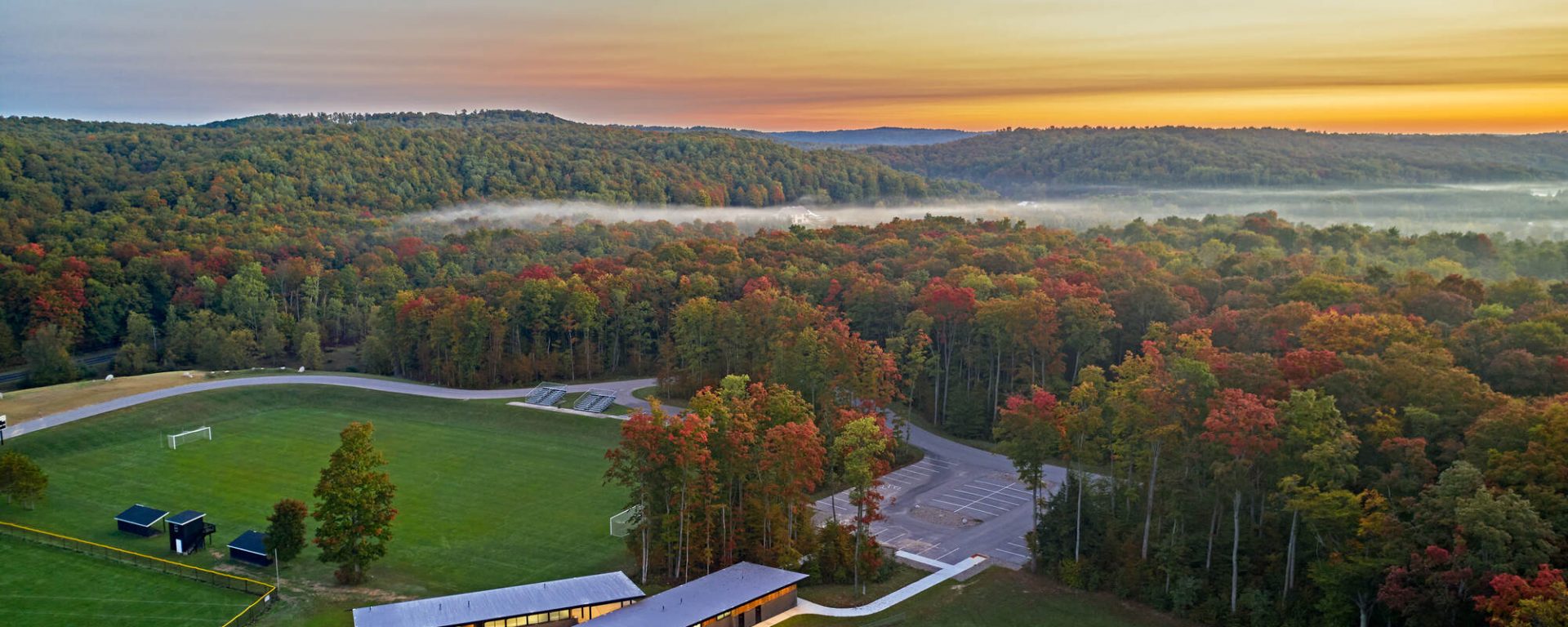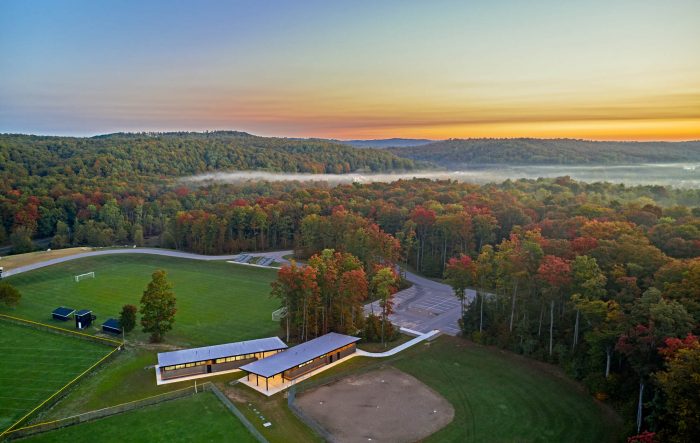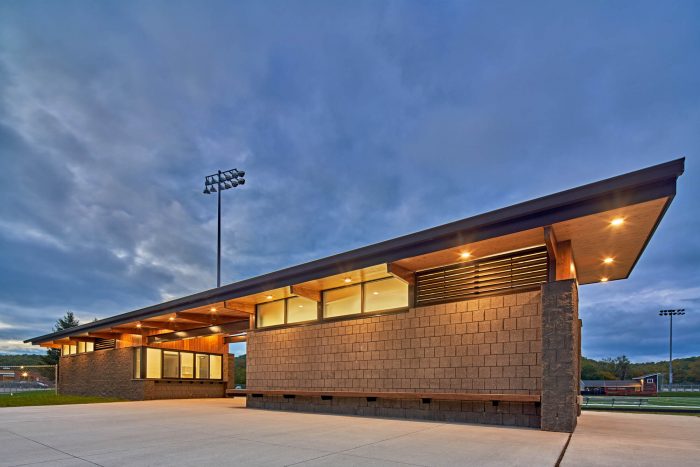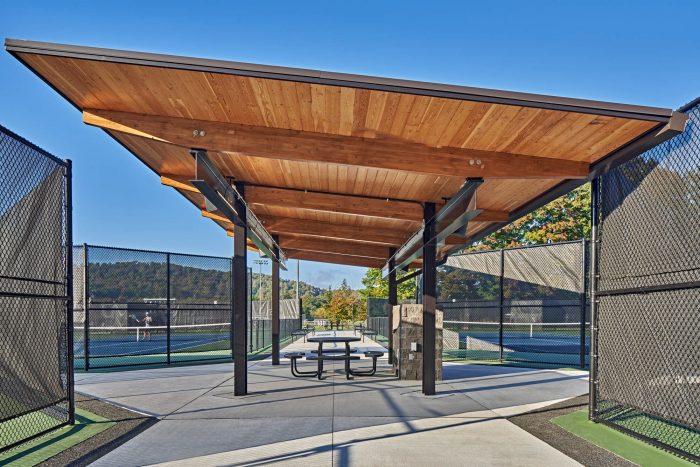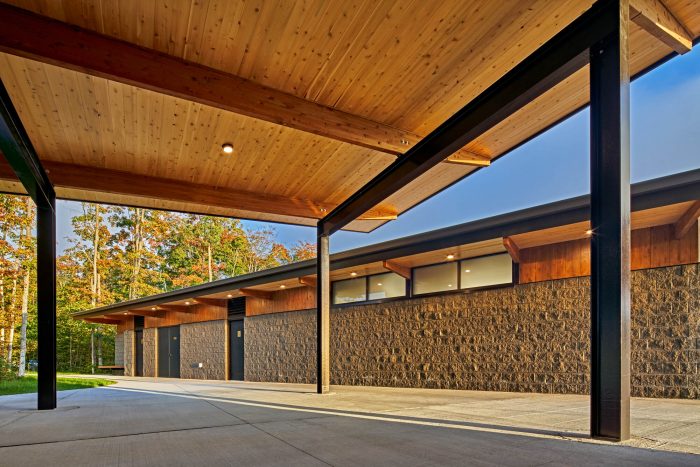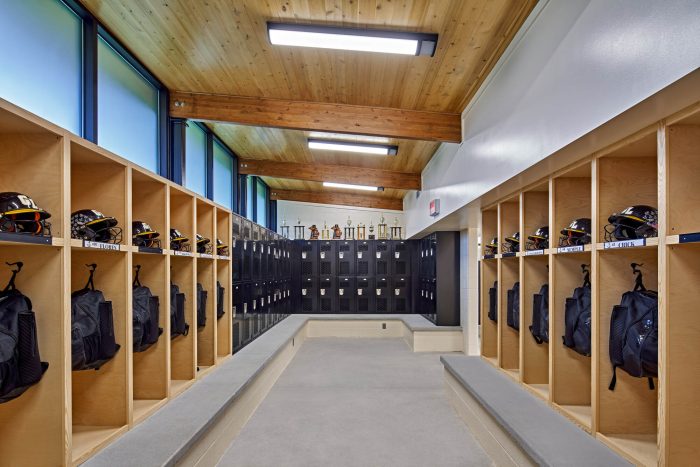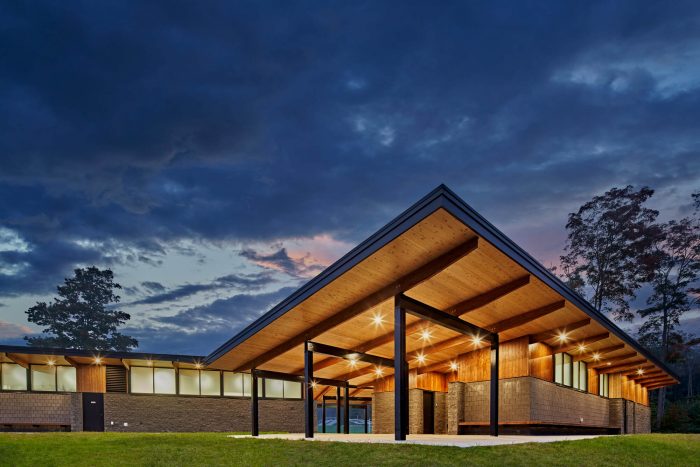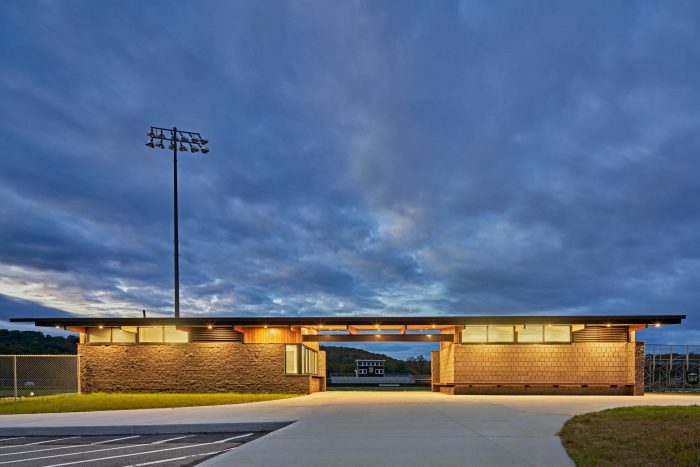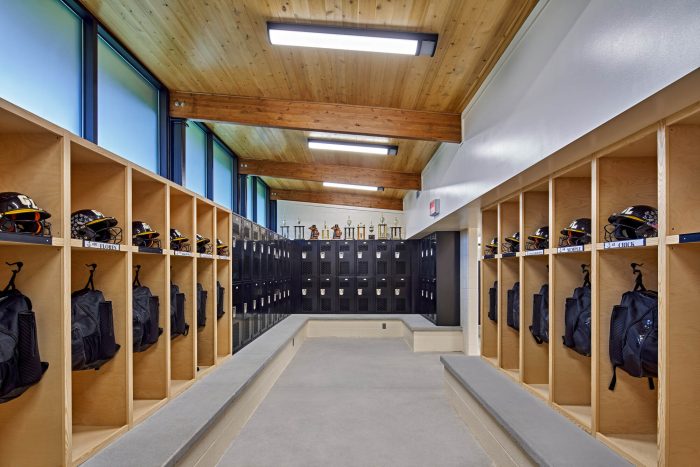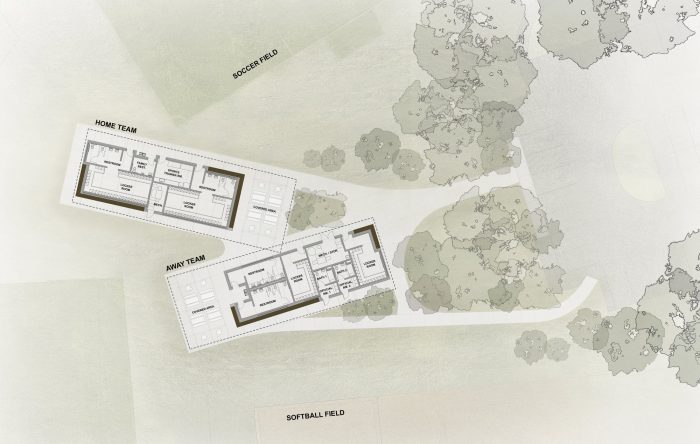格伦湖社区学校(GLCS)位于密歇根州北部的110英亩土地上,该地区以其自然美景而闻名。由于现有场地缺乏比赛用的网球场,学生不得不使用其他地区的球场–作为 “访客 “队。垒球场和足球场离更衣室很远,因此很不方便。
Glen Lake Community Schools (GLCS) is located on 110 acres in northern Michigan, an area well-known for its natural beauty. Because the existing site lacked competition tennis courts, students had to use courts in other districts – as the “visitor” team. The softball and soccer fields were distant from the locker rooms, making them inconvenient.
这些因素导致项目范围由三个部分组成:在现有球场附近的垒球和足球的主队和客队更衣室建筑;一个新的8个球场的网球馆;以及一个控制进入足球场和为网球馆提供存储的门户建筑。一个主要的设计目标是为所有的建筑创造一个共同的、实用的美学,在视觉上将它们统一在一片广阔的土地上。作为密歇根州绿色学校的成员,GLCS致力于通过良好的生态实践和环境原则教学来实现环境目标。因此,高性能和可持续设计是明确的优先事项。
These factors resulted in a project scope comprised of three components: home and visitor team locker room buildings for softball and soccer adjacent to the existing fields; a new 8-court tennis complex; and a gateway building to control admission to the football stadium and to provide storage for the tennis complex. A primary design goal involved creating a common, practical aesthetic for all buildings that would visually unite them across an expanse of many acres. As a member of Michigan Green Schools, GLCS is dedicated to achieving environmental goals through good ecological practices and teaching environmental principles. As a result, high-performance and sustainable design were clear priorities.
设计过程中,首先对每栋建筑进行了场地循环和定位研究,以了解自然入口和焦点,以便直观地找到方向,并最大限度地利用自然光、景观、遮蔽的聚会空间和未来的太阳能电池组。虽然这块土地很大,但起伏的地形和现有的场地只为建筑物提供了小而不规则的场地。场地规划还需要容纳新的化粪池,雨水保留,以及连接到远程水电服务,同时尽可能保留现有的树丛。
The design process began with a site circulation and orientation study for each building to understand natural entry and focal points for intuitive wayfinding, and to maximize natural light, views, sheltered gathering spaces, and future solar arrays. Although the property is large, the undulating topography and existing field locations offered only small, irregular sites for the buildings. The site planning also needed to accommodate new septic fields, stormwater retention, and connection to remote water and electric services, while retaining existing tree groves wherever possible.
建筑物的定位是为了最大限度地方便运动员和观众的场地流通和进出,同时也为所有天气提供庇护。自然光和自然材料的使用提供了一种独特的美学,代表了格兰湖和密歇根州北部森林的特点。有意使用木材作为结构和饰面材料是实现设计的关键,这种设计是受欢迎的,并在视觉上与周围的森林环境相联系。它还为该地未来建筑的特点和设计树立了一个重要的先例。
The buildings are positioned to maximize convenient site circulation and access for athletes and spectators, while also offering shelter in all weather. The use of natural light and natural materials provides a distinct aesthetic, representational of Glen Lake and Michigan’s north woods. The intentional use of wood as structural and finish materials was key in achieving designs that are welcoming and visually connected with the forested surroundings. It also sets an important precedent for the character and design of future buildings on site.
木质天花板、外部镶板、综合木质长椅和胶合木梁在一个简单的调色板中一起工作,帮助将设计从一个 “功利 “的结构提升到一个社区资产。分体式混凝土墙和抛光混凝土墙为建筑外墙提供了低维护的解决方案。
Wood ceilings, exterior paneling, integrated wood benches, and glulam beams work together in a simple palette that help lift the design from a “utilitarian” structure to a community asset. Split-face and burnished concrete block walls provide a low-maintenance solution to building exteriors.
团队建筑的特点是低斜的、重叠的屋顶,创造了一个大的、受保护的区域。这些建筑包括训练室、官员更衣室、学生运动员设施和方便的公共厕所。门口/门票建筑是通往足球场的一个重要的视觉入口。入口广场上有综合长椅,促进了比赛前后的聚会。建筑物长轴的总体方向加强了采光和遮阳策略,以减少眩光和太阳辐射。
因为这些建筑如此紧密地反映了格伦湖的文化和环境目标,所以这些项目很可能会被尊重为有价值的代表,并作为社区值得保留的例子保留到未来。这样一来,这些建筑的设计提供了跨越社会、经济和环境的多重利益。
The team buildings feature low-sloping, overlapping roofs, creating a large, protected area. The buildings include training rooms, officials’ locker rooms, student-athlete facilities, and convenient public restrooms. The gateway/ticket building frames an important visual entry to the football field. The entry plaza, with integrated bench seating, promotes gathering before and after games. The general orientation of the long axis of the buildings enhances daylighting and shading strategies to minimize glare and solar heat gain.
Because these buildings so closely reflect the cultural and environmental goals of Glen Lake, it is likely that these projects will be respected as worthy representatives and retained as examples of the community worth retaining for the future. In this way, the design of these buildings provides multiple benefits across social, economic, and environmental lines.
Architects: Mathison | Mathison Architects
Area : 4000 ft²
Year : 2021
Photographs :Jason Keen
Manufacturers : Sherwin-Williams, Corian, Fórmica, Michigan Certified Concrete
Interior Design : Mathison | Mathison Architects
Design Principal : Evan Mathison
Principal In Charge : Tom Mathison
Project Architect : Jeff Montague
Project Coordinator : Matt Mcdonald
General Contractor : The Christman Company
Landscape Architect + Civil Engineer : Gosling Czubak Engineering
City : Maple City
Country : United States

